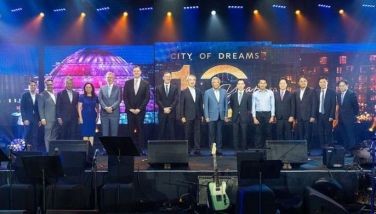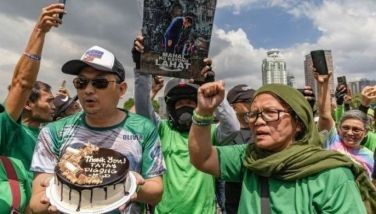Suggestions

Last week a visitor I know to be always prompt called to say she would be late for an afternoon meeting at our office. Half an hour past the original schedule, she called again to inform us that she was still stuck along Gil Puyat Street and asked to reset the meeting.
That was end-of-the-month, long-weekend payday Friday, the start of major sales at several shopping malls all over Metro Manila. It was also the height of the temper tantrum staged by the Iglesia ni Cristo (INC) from Padre Faura in Manila to EDSA-Shaw in Mandaluyong (later extending to the EDSA Shrine in Ortigas).
On that day it took me two hours in the early afternoon to reach our office in Manila’s Port Area from EDSA-Shaw even with reckless driving – a trip that usually takes no more than 45 minutes. I was lucky because the INC shock troops were just starting to gather at EDSA. There are enough traffic horror stories on that day to fill the INC hate mail box to overflowing until 2020.
But the INC weekend was just the worst of it. Every day people in Metro Manila stew and cuss and waste precious hours, losing productivity (a staggering P2.4 billion daily is the current Metro-wide estimate) and worsening air pollution as vehicles idle or crawl in traffic, with no one seeming to be in charge except for the occasional appearance of some public official, TV crews in tow, to personally direct traffic for a few minutes.
The traffic doesn’t end after rush hour. Just try driving southbound along Roxas Boulevard, MIA Road and Macapagal Boulevard late at night, where potholes as large as moon craters plus construction of the NAIA Expressway have spelled hell for motorists for several weeks now. Will the gridlocks last throughout the rainy season?
Chairman Francis Tolentino of the Metropolitan Manila Development Authority (MMDA), who’s distracted from traffic management by his senatorial ambitions, said the traffic situation is expected to get worse in the next 15 years.
Give him an A for candor and a D for political savvy with elections approaching. Already there’s a surfeit of jokes about walang madaanan, baradong daan, baku-bakong daan and many other wordplays on tuwid na daan or straight path. If Tolentino continues on his campaign path and President Aquino doesn’t do more about the traffic problem, the mess could become an election issue in 2016 in vote-rich Metro Manila.
* * *
Beyond carping, I’ve listed down some of the suggestions (aside from looking for an efficient traffic czar) given by harried motorists and commuters to ease traffic. Several have in fact been proposed by business groups in the past years and listed in several comprehensive studies on the traffic situation.
Among the suggestions that can be implemented relatively quickly, with political will and resources:
The Subic port must be put to greater use for shipments bound for Central and parts of Northern Luzon. For Southern Tagalog, the Batangas port is underutilized and Sangley Point can be developed. This will decongest the Port of Manila, Ground Zero of last year’s traffic mess, which may soon be Ground Zero again with the approach of the Christmas season. The Joint Foreign Chambers of Commerce has been pushing for the greater utilization of alternative ports for some time.
Logistics players and port officials have raised the issue of lack of manpower and additional costs in terms of overtime, but suggestions persist for midnight to 5 a.m. operations for cargo hauling at the Port of Manila, on top of regular hours, with schedules assigned to haulers electronically.
Garbage collection must be done at night for dumping at trash sites between midnight and 5 a.m.
Sidewalks on streets with high traffic density must be reclaimed for pedestrian use, cleared of vendors, barangay halls and long-running wakes used as fronts for illegal gambling.
Motorcycle traffic needs better regulation.
Keep out pedicabs, tricycles, horse-drawn vehicles and other slow-moving vehicles from main thoroughfares. As in sidewalk vending, there are in fact local ordinances for this that are never enforced even along main roads.
Open certain strategic roads in private gated subdivisions – something that will soon be done in Parañaque. More subdivision roads need to be opened elsewhere, including in Quezon City and San Juan.
Land transportation agencies must intensify the campaign against colorum public utility vehicles – one of the biggest contributors to high vehicle density along EDSA and other major thoroughfares. The problem here is that a number of PUV operators happen to be well-connected.
The right connections also stymie attempts to regulate the entry of provincial buses in Metro Manila through the setting up of special depots, or to prevent buses from turning strategic spots into virtual terminals.
Transport officials have admitted difficulty in preventing PUV operators from imposing a boundary system on drivers. Admitting difficulty is not good enough; President Aquino should find someone who can do the job. When drivers’ daily earnings depend on the number of passengers they can transport per trip, they linger at every stop and pick up passengers even in the middle of the street.
These days, concerns have been raised about the possibility of more kotong or extortion after P-Noy designated the police Highway Patrol Group as the lead enforcer of traffic rules along EDSA. One suggestion is to require payment of all traffic violation fines in accredited banks, although this won’t prevent traffic enforcer and motorist from agreeing to the equivalent of an out-of-court settlement, without any receipt, just to avoid further hassle.
* * *
For the long-term, serious consideration should be given to creating an elective position for governor of Metro Manila. Traffic management cannot be left to the disjointed responses of the elected mayors of the metropolis, which was again evident during the INC protests. Any MMDA chief, a presidential appointee, always finds it tough to impose authority over mayors who often belong to political dynasties ruling the independent republics of Metro Manila.
Finally, everyone knows the mass transportation system must first be improved if the government wants people to leave private vehicles at home – which makes you wonder why action on this issue since 2010 has been going in the opposite direction. From the performance of the folks in charge of this under daang matuwid, we will just have to hope for a new team to come in next year.
At this point, unfortunately, it looks like the MMDA chief’s candid assessment of the duration of the traffic mess won’t be far off the mark.
- Latest
- Trending



























